
Wine Culture and Information since 2002 - Volume 22
 Wine Culture and Information since 2002 - Volume 22 |
|
Cabernet SauvignonNow spread in every wine producing country of the world, Cabernet Sauvignon has always been charming for its full bodied and elegant wines that from Bordeaux have conquered the world |
|
Cabernet Sauvignon is one of those grapes which are often subject of conversations among wine lovers, so famous and celebrated that even the most neophyte of the beverage of Bacchus lovers has heard of it at least once and, highly probable, has also tasted at least one wine in which it was present. Usually associated to great wines - elegant and important - Cabernet Sauvignon is particularly remembered for the body and structure of its wines, as well as for its charming aromas and strong flavors. Cabernet Sauvignon, from its homeland, which is identified with good certainty in the Bordeaux region, is now and practically present in every country of the world where wine is being produced and it also belongs to the argued group - in good and bad sense - of the so called international grapes. Cabernet Sauvignon is so spread in the world that, alone and frequently together with Merlot, is used in blends together with the local grapes of the countries where it is cultivated, however it is often vinified alone as well. The origins of this grape have been for many centuries uncertain and not very clear. Reliable information about Cabernet Sauvignon suggest that the first area in which this grape was intensively and extensively cultivated was the region of Bordeaux, that is the region that still today is considered as its preferred land and, in particular, the Médoc. Historical evidences tell that the grape began to concretely spread in the Bordeaux area around the end of the eighteenth century. Studies about the classification and the description of Cabernet Sauvignon have convinced researchers this grape probably is the famous Biturica vine, praised and described by Pliny the Elder in his monumental work Naturalis Historia. The name Biturica derives from the Biturigi people that at those times lived in the northern part of the Pyrenees. Recent researches done at the University of Bordeaux about the genetic characteristics of Cabernet Sauvignon have allowed to solve its origin - surprising, amazing and exciting - and it seems this grape was a spontaneous crossing between Cabernet Franc and Sauvignon Blanc, from which it also took part of their names to form its own name.
The spreading of Cabernet Sauvignon in the world is so wide that often it is simply defined as “Cabernet”. The use of this abbreviation, to tell the truth, too much abused, has been the origin of some misunderstandings and confusions in the proper identification of the wines produced with this grape. Whether it is true that most of the times the use of the term “Cabernet” is referred to Cabernet Sauvignon, it is also true that in some areas, when this term is used, they usually refer to Cabernet Franc. Moreover in some wines produced in the north-eastern part of Italy - in particular in Veneto and Friuli Venezia Giulia - it is pretty frequent to find in labels of bottles the definition “Cabernet” only and this is usually referred to a wine made from both Cabernet Franc and Cabernet Sauvignon of which, highly probable, it is Cabernet Franc to represent the higher percentage. Cabernet Sauvignon is a grape capable of producing wines from pretty ordinary to extremely and magnificently elegant and refined, in which are clearly expressed, something that always happens for any other grape, the typicality of the territory, and more concretely, the cultural practices and the vinification techniques used for the production. Cabernet Sauvignon bears bunches with pretty small berries and with thick skin, rich in colorant substances and tannins, with a pretty high ratio to the juice. Thanks to this characteristic, the wines produced with this grape, provided it was properly cultivated, are always pretty robust and tannic, a condition which often - and traditionally - favors the adding of Merlot in order to smooth and soften the finished product. Cabernet Sauvignon is a late ripening grape and therefore is cultivated with good results and preferably in warm climate areas. The most frequent vinification practice of Cabernet Sauvignon makes use of casks - and more specifically barrique - which contributes both to smooth the strong astringency - by adding softer and sweeter wood tannins - and to give olfactory and gustatory organoleptic qualities of high agreeability. The longevity of wines made from Cabernet Sauvignon is pretty variable and it strongly depends on how the grape was cultivated and vinified. The acidity of Cabernet Sauvignon is pretty high and this characteristic, as well as the high quantity of tannins, allows its wines to remarkable period of aging. The longevity of Cabernet Sauvignon can range from 3 or 4 years - in case it was cultivated with high yields and vinified in an ordinary way - up to more than 20 years in case it was cultivated with low yields and vinified according to quality criteria. Because of its late ripening, this grape is not suitable in pretty cold climate areas. The aromatic range of Cabernet Sauvignon is strongly influenced both by the area and the type of soil in which it was cultivated and the level of ripeness at the time of harvesting. The aromatic characteristic that more than any other else distinguishes this grape is the aroma of black currant, a quality which is practically found in every Cabernet Sauvignon cultivated in every place of the world. When this grape is being harvested underripe or not completely ripe, the aromatic qualities are strongly characterized by evident aromas of vegetal and herbaceous substances which are directly associated to the ones of Cabernet Franc. Cabernet Sauvignon, just like Merlot, has a so high reputation and esteem among wine lovers and wine makers that it is frequently used in wines with the explicit goal - and hope - to improve a modest product in order to make it more “elegant” and “important”. Whether it is true that by using Cabernet Sauvignon can be frequently achieved such results, it must be remembered - always and however - that the presence of this grape in a wine, or of any other else, does not represent a guarantee of quality. Cabernet Sauvignon cultivated with high yields makes pretty ordinary and mediocre wines, just like any other grape, therefore it is necessary to consider it with proper distinctions - in particular when “famous” international grapes are used in the blend - between real quality and plain speculation.
|
||||||||
|
Cabernet Sauvignon has a skin which is generally rich in colorant substances therefore - according to the area in which the grape was cultivated, the level of ripeness at the time of harvesting and cultural yields - wines produced with this grape show pretty intense colors. Because of its colorant capacity, wines produced with Cabernet Sauvignon cultivated with qualitatively acceptable practices, have a pretty low transparency and sometimes they are almost impenetrable to light. During youth - a period that for quality Cabernet Sauvignon wines can also last many years - color gets intense and deep ruby red hues with evident purple red nuances. The evolution of the color of Cabernet Sauvignon - capable of producing wines of remarkable longevity - is pretty slow and quality wines tend to get to garnet red colors after many years, sometimes even more than ten years. In wines produced with pretty low quality criteria - first of all excessive cultural yields - transparency will be pretty high and the evolution of the color will follow a pretty quick cycle and after three or four years it will be turned into a garnet red color.
|
|
The aromatic qualities of Cabernet Sauvignon are generally well identifiable thanks to the presence of strong and clean aromas of black berried fruits where the most recognizable ones are black currant and black cherry. Wines produced with Cabernet Sauvignon are generally fermented and aged in cask therefore also aromas of vanilla and toasted wood - sometimes cedar wood or cigar box - will be present with more or less accentuated intensities. Grapes cultivated in cool climate areas, or harvested when they did not reach full ripeness, produce wines with evident herbaceous and vegetal aromas, such as tomato leaf, bell pepper, olive and bruised black currant leaf, as well as aromas of black berried fruits, such as black cherry, black currant, blueberry and plum. In grapes cultivated in warm climate areas or however harvested at full ripeness, aromas of the herbaceous and vegetal families tend to disappear - most of the times completely - and pleasing and intense aromas of fruits, in particular black currant, black cherry, plum and blueberry can be perceived, sometimes also as jams, and it is usual to find an aroma of violet as well. In wines produced with Cabernet Sauvignon are frequent aromas of licorice and tobacco, as well as other unmistakable aromas passed from wood during the aging period, such as vanilla, cigar box, coffee and cedar wood. Balsamic aromas are also frequent of which the most common ones are eucalyptus and menthol. With times the aromas of Cabernet Sauvignon - also thanks to its excellent longevity - follow an interesting evolution and aromas of fruit are transformed into rich jams, moreover aromas of cocoa, chocolate and leather can be perceived as well, and with some more aging, balsamic aromas get more intense whereas elegant aromas of underbrush and mushrooms begin to develop. In wines produced with Cabernet Sauvignon is also common to find aromas of spices such as cinnamon, clover, nutmeg, rhubarb, black pepper and cinchona.
|
||||
|
Cabernet Sauvignon is characterized by a high quantity of polyphenolic substances - tannins - and a pretty high acidity which are both found in the taste of its wines. The skin of this grape is pretty thick and therefore the juice will be rich in solid substances capable of producing full bodied wines with robust structures and pretty high extracts. Wines produced with Cabernet Sauvignon are generally pretty alcoholic - from moderate to high - an essential requisite in order to balance the strong astringency produced by tannins. In wines produced with quality standards - low yields and right wine making practices - the main characteristics will be represented by a robust structure and appreciable astringency, as well as a pretty high percentage of alcohol. In low quality wines, the astringency will be lower and the percentage of alcohol will be lesser and in these cases wines are pretty ordinary and common. The astringency and the robust structure of Cabernet Sauvignon are usually the result of precise productive choices in order to make wines suitable for long aging periods in bottle.
|
|
Cabernet Sauvignon is considered among the most known and spread international grapes and it is practically present in all the wine producing countries of the world. Its homeland is however the Bordeaux region - in particular the Médoc and the Graves - where the wines produced with this grape, besides being characterized by elegance and finesse, are considered as the reference model all over the world. In these areas, where gravelly soils keep the heat capable of favoring ripeness, Cabernet Sauvignon is practically present in every wine together with Merlot and Cabernet Franc, its most renowned allies in this region. Wines from Saint-Estèphe are characterized by strong aromas of fruit and good body, whereas in Pauillac, with its gravelly soils, Cabernet Sauvignon wines have robust structures. The less gravelly soil in Saint-Julien produces less tannic Cabernet Sauvignons than Pauillac, whereas in Margaux wines have a higher elegance and finesse. In the Graves this grape produces very interesting wines characterized by aromas of fruit and sometimes “earthy” as well. Other French areas in which Cabernet Sauvignon is cultivated are the Loire Valley, South-West, Languedoc and Provence. Outside the French borders Cabernet Sauvignon is present everywhere. In Italy is frequently used together with the typical grapes of the many regions and it can also be found vinified alone. In Spain Cabernet Sauvignon is present in modest quantities and with appreciable results. In Europe this grape is also present in Austria, Greece, Bulgaria and Hungary. In the rest of the world - that is in those countries considered as the “New World” - Cabernet Sauvignon has now a strong and solid presence. The grape is very common in California and in particular in Napa Valley where are being produced excellent wines with this grape. Even the neighboring Washington state produces Cabernet Sauvignon of remarkable quality and certainly to be considered among the best ones of the country. In South America Cabernet Sauvignon is present in Chile - in particular in Maipo Valley - and in Argentina, at Mendoza. Australia produces different styles of Cabernet Sauvignon where Coonawarra is probably the most representative region. The cool climate of New Zealand produces interesting Cabernet Sauvignons, with herbaceous tastes and aromas which are frequently mitigated by Merlot. In South Africa this grape is often used together with other grapes, however here can be found good examples of wines exclusively produced with Cabernet Sauvignon.
|
Wines of the Month |
|
|
|
Score legend Prices are to be considered as indicative. Prices may vary according to the country or the shop where wines are bought |
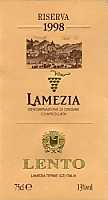
|
|
Lamezia Rosso Riserva 1998 |
|
| Cantine Lento (Italy) | |
| Grapes: Magliocco (35%), Greco Nero (35%), Nerello (30%) | |
| Price: € 11,00 | Score: |
| The wine shows a brilliant ruby red color and nuances of garnet red, moderate transparency. The nose reveals intense, clean, pleasing and refined aromas which start with hints of black cherry jam and cherry followed by aromas of raspberry, dried plum, dried violet, licorice, tobacco, cocoa, vanilla and hints of menthol. In the mouth has good correspondence to the nose, a slightly tannic attack and however balanced by alcohol, good body, intense, flavors, good tannins, agreeable. The finish is persistent with flavors of plum and black cherry jam. This wine ages in barrique for 12 months and for 6 months in bottle. | |
| Food Match: Roasted meat, Hard cheese, Stewed meat | |
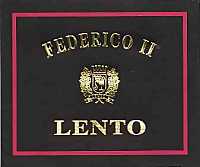
|
|
Federico II 2001 |
|
| Cantine Lento (Italy) | |
| Grapes: Cabernet Sauvignon | |
| Price: € 11,00 | Score: |
| The wine shows a brilliant ruby red color and nuances of ruby red, little transparency. The nose reveals intense, clean, pleasing and elegant aromas that start with hints of black cherry and plum followed by aromas of raspberry, blackberry, licorice, black currant, dried violet, vanilla and hints of tobacco, eucalyptus and cocoa. In the mouth has good correspondence to the nose, a slightly tannic attack and however balanced by alcohol, full body, intense flavors, good tannins. The finish is persistent with flavors of plum and black cherry. A well made wine. Federico II ages for 12 months in barrique followed by 6 months of aging in bottle. | |
| Food Match: Game, Roasted meat, Braised and stewed meat, Hard cheese | |
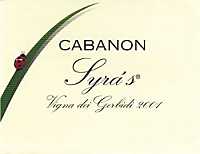
|
|
Syra's Vigna dei Gerbidi 2001 |
|
| Fattoria Cabanon (Italy) | |
| Grapes: Syrah | |
| Price: € 17,50 | Score: |
| This wine shows an intense ruby red color and nuances of ruby red, little transparency. The nose denotes intense, clean, pleasing and refined aromas which start with hints of black cherry and plum followed by aromas of blueberry, blackberry, tobacco, licorice, vanilla and hints of black pepper. In the mouth has good correspondence to the nose, a slightly tannic attack and however balanced by alcohol, good body, intense flavors, good tannins. The finish is persistent with flavors of plum and black cherry. This wine ages for 6 months in barrique. | |
| Food Match: Stuffed pasta with mushrooms, Roasted meat, Stewed meat with mushrooms | |
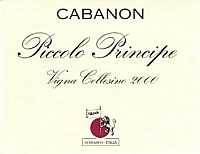
|
|
Oltrepò Pavese Rosso Piccolo Principe Vigna Collesino 2001 |
|
| Fattoria Cabanon (Italy) | |
| Grapes: Barbera | |
| Price: € 22,00 | Score: |
| This wine shows an intense ruby red color and nuances of ruby red, little transparency. The nose reveals good personality with intense, clean, pleasing, elegant and refined aromas which start with hints of black cherry and plum followed by good aromas of blueberry jam, black currant, violet, tobacco, licorice, vanilla, chocolate and hints of cinnamon and clover. In the mouth has very good correspondence to the nose, a slightly tannic attack and a pleasing crispness, however well balanced by alcohol, full body, intense flavors, good tannins, agreeable. The finish is persistent with good flavors of blueberry jam, plum and black cherry. Piccolo Principe ages for 12 months in barrique. | |
| Food Match: Braised and stewed meat, Roasted meat, Hard cheese | |
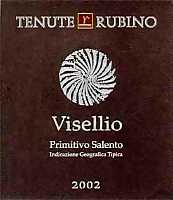
|
|
Visellio 2002 |
|
| Tenute Rubino (Italy) | |
| Grapes: Primitivo | |
| Price: € 15,00 | Score: |
| The wine shows a deep ruby red color and nuances of ruby red, little transparency. The nose reveals good personality with intense, clean, pleasing, refined and elegant aromas which start with hints of black cherry, blueberry and blackberry followed by aromas of plum, violet, tobacco, licorice, vanilla and hints of chocolate and eucalyptus. In the mouth has good correspondence to the nose, a slightly tannic attack and however balanced by alcohol, full body, intense flavors, good tannins. The finish is persistent with flavors of black cherry, plum and blackberry. A well made wine. Visellio ages for 8 months in barrique. | |
| Food Match: Braised and stewed meat, Roasted meat, Game, Hard cheese | |
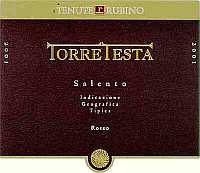
|
|
Torre Testa 2001 |
|
| Tenute Rubino (Italy) | |
| Grapes: Susumaniello | |
| Price: € 15,00 | Score: |
| This wine shows a deep ruby red color and nuances of ruby red, little transparency. The nose reveals good personality with intense, clean, pleasing, refined and elegant aromas which start with hints of black cherry and blackberry followed by good aromas of blueberry, plum, black currant, tobacco, violet, licorice, vanilla and hints of chocolate and menthol. In the mouth has good correspondence to the nose, a slightly tannic attack and however balanced by alcohol, full body, intense flavors, good tannins, agreeable. The finish is very persistent with flavors of blackberry, plum and black cherry. A well made wine. Torre Testa ages for 14 months in barrique. | |
| Food Match: Roasted meat, Braised and stewed meat, Game, Hard cheese | |

|
|
Friuli Isonzo Tocai Friulano 2002 |
|
| Borgo San Daniele (Italy) | |
| Grapes: Tocai Friulano | |
| Price: € 15,00 | Score: |
| The wine shows a pale straw yellow color and nuances of greenish yellow, very transparent. The nose reveals intense, clean, pleasing and refined aromas which start with hints of almond, plum and hawthorn followed by aromas of yeast, apple, pear, grapefruit and hints of mineral. In the mouth has good correspondence to the nose, a crisp attack and however well balanced by alcohol, good body, intense flavors, agreeable. The finish is persistent with flavors of plum, pear and almond. | |
| Food Match: Fish appetizers, Pasta and risotto with fish and crustaceans, Fried fish | |

|
|
Friuli Isonzo Arbis Blanc 2002 |
|
| Borgo San Daniele (Italy) | |
| Grapes: Sauvignon Blanc (40%), Chardonnay (40%), Tocai Friulano (20%), Pinot Blanc (20%) | |
| Price: € 16,00 | Score: |
| The wine shows a brilliant straw yellow color and nuances of greenish yellow, very transparent. The nose reveals good personality with intense, clean, pleasing, refined and elegant aromas which start with hints of peach and litchi followed by good aromas of acacia, pineapple, banana, hawthorn, broom, almond, grapefruit and hints of elder and mineral. In the mouth has good correspondence to the nose, a crisp attack and pleasing roundness, well balanced by alcohol, good body, intense flavors, agreeable. The finish is persistent with flavors of peach, litchi and pear. A well made wine. | |
| Food Match: Fish soups, Pasta and risotto with fish and crustaceans, Broiled fish | |
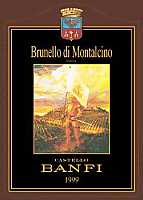
|
|
Brunello di Montalcino 1999 |
|
| Castello Banfi (Italy) | |
| Grapes: Sangiovese Grosso | |
| Price: € 32,00 | Score: |
| The wine shows a deep ruby red color and nuances of garnet red, little transparency. The nose reveals intense, clean, pleasing, refined and elegant aromas which start with good hints of black cherry and plum followed by aromas of blackberry, blueberry, licorice, tobacco, cinnamon, vanilla and hints of eucalyptus. In the mouth has good correspondence to the nose, a tannic attack and however balanced by alcohol, full body, intense flavors, robust tannins. The finish is persistent with flavors of black cherry, plum and blueberry. A well made wine that will give its best with some years of aging in bottle. This Brunello ages for 24 months in cask. | |
| Food Match: Game, Braised and stewed meat, Hard cheese | |
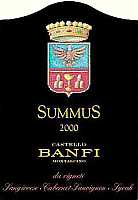
|
|
Sant'Antimo Summus 2000 |
|
| Castello Banfi (Italy) | |
| Grapes: Sangiovese (45%), Cabernet Sauvignon (45%), Syrah (15%) | |
| Price: € 35,00 | Score: |
| This wine shows a deep ruby red color and nuances of ruby red, little transparency. The nose reveals good personality with intense, clean, pleasing, refined and elegant aromas which start with good hints of plum jam, black cherry and blueberry followed by good aromas of blackberry, black currant, dried violet, cyclamen, licorice, tobacco, cocoa, cinnamon, vanilla and hints of menthol. In the mouth has good correspondence to the nose, a slightly tannic attack and however well balanced by alcohol, full body, intense flavors, good tannins. The finish is persistent with good flavors of black cherry, plum and blueberry. A well made wine. Summus ages for 23 months in cask. | |
| Food Match: Game, Braised and stewed meat, Hard cheese | |
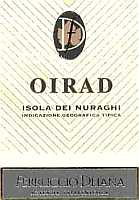
|
|
Oirad 2003 |
|
| Ferruccio Deiana (Italy) | |
| Grapes: Nasco, Moscato Bianco, Malvasia Bianca | |
| Price: € 16,50 - 375ml | Score: |
| This wine shows a brilliant amber yellow color and nuances of amber yellow, very transparent. The nose reveals intense, clean, pleasing, elegant and refined aromas which start with hints of dried fig, candied fruit and honey followed by aromas of dried apricot, chamomile, quince jam, date, litchi, almond and ripe peach. In the mouth has very good correspondence to the nose, a sweet and round attack however well balanced by alcohol, good body, intense flavors, pleasing sweetness. The finish is very persistent with flavors of dried apricot, litchi and honey. A well made wine. | |
| Food Match: Almond cakes, Hard and piquant cheese, Confectionery | |

|
|
Ajana 2000 |
|
| Ferruccio Deiana (Italy) | |
| Grapes: Cannonau (40%), Carignan (40%), Cabernet Sauvignon (20%) | |
| Price: € 27,00 | Score: |
| The wine shows an intense ruby red color and nuances of garnet red, little transparency. The nose reveals good personality with intense, clean, pleasing, elegant and refined aromas which start with hints of black cherry, plum and vanilla followed by aromas of raspberry, blueberry, blackberry, cyclamen, tobacco, dried violet and hints of black pepper. In the mouth has very good correspondence to the nose, a slightly tannic attack and however balanced by alcohol, good body, intense flavors, good tannins, round and agreeable. The finish is persistent with flavors of blackberry, plum and black cherry. A well made wine. Ajana ages for 18 months in barrique followed by 3 months in bottle. | |
| Food Match: Stewed and braised meat with mushrooms, Roasted meat, Hard cheese | |

|
|
Cortona Merlot Desiderio 2000 |
|
| Avignonesi (Italy) | |
| Grapes: Merlot (85%), Cabernet Sauvignon (15%) | |
| Price: € 37,00 | Score: |
| The wine shows an intense ruby red color and nuances of garnet red, little transparency. The nose reveals intense, clean, pleasing, refined and elegant aromas which start with hints of black cherry, blackberry and violet followed by aromas of blueberry, plum, black currant, tobacco, licorice, vanilla and pleasing hints of menthol. In the mouth has good correspondence to the nose, a slightly tannic attack and however well balanced by alcohol, full body, intense flavors, good tannins. The finish is persistent with flavors of black cherry, plum and blueberry. A well made wine. Desiderio ages for 18 months in barrique. | |
| Food Match: Game, Roasted meat, Braised and stewed meat, Hard cheese | |
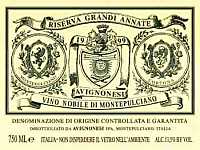
|
|
Vino Nobile di Montepulciano Riserva Grandi Annate 1999 |
|
| Avignonesi (Italy) | |
| Grapes: Prugnolo Gentile (85%), Cabernet Sauvignon (15%) | |
| Price: € 40,00 | Score: |
| This wine shows an intense ruby red color and nuances of garnet red, little transparency. The nose reveals good personality with intense, clean, pleasing, refined and elegant aromas which start with hints of blackberry, black cherry and blueberry followed by aromas of raspberry, cyclamen, violet, black currant, plum, licorice, pink pepper, vanilla and pleasing hints of chocolate. In the mouth has very good correspondence to the nose, a slightly tannic attack and however well balanced by alcohol, full body, intense flavors, good tannins. The finish is persistent with flavors of blackberry, black cherry and plum. A well made wine. This Nobile di Montepulciano ages for 30 months in barrique and in bottle for 6 months. | |
| Food Match: Game, Roasted meat, Braised and stewed meat, Hard cheese | |
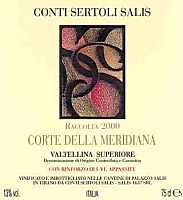
|
|
Valtellina Superiore Corte della Meridiana 2000 |
|
| Conti Sertoli Salis (Italy) | |
| Grapes: Nebbiolo (Chiavennasca) | |
| Price: € 17,00 | Score: |
| The wine shows a brilliant ruby red color and nuances of garnet red, moderate transparency. The nose reveals intense, clean, pleasing and refined aromas which start with hints of cherry and raspberry followed by aromas of plum, dried violet, dried rose, licorice, cyclamen, vanilla and hints of cinnamon. In the mouth has good correspondence to the nose, a slightly tannic attack and pleasing crispness, however balanced, good body, intense flavors, good tannins. The finish is persistent with flavors of plum and black cherry. This wine is produced with the technique of “rinforzo” (adding of must produced by dried grapes), ages for 18 months in cask and for at least 6 months in bottle. | |
| Food Match: Roasted meat, Game, Braised and stewed meat with mushrooms, Hard cheese | |

|
|
Sforzato di Valtellina Canua 2001 |
|
| Conti Sertoli Salis (Italy) | |
| Grapes: Nebbiolo (Chiavennasca) | |
| Price: € 28,80 | Score: |
| The wine shows a brilliant ruby red color and nuances of garnet red, moderate transparency. The nose reveals good personality with intense, clean, pleasing, refined and elegant aromas that start with hints of black cherry, plum and blackberry followed by aromas of raspberry, licorice, violet, dried rose, vanilla and cinnamon. In the mouth has good correspondence to the nose, a slightly tannic attack and pleasing crispness, however well balanced by alcohol, good body, intense flavors, good tannins. The finish is persistent with flavors of black cherry, raspberry and plum. A well made wine. This Sforzato ages for 24 months in cask and for at least 6 months in bottle. | |
| Food Match: Braised and stewed meat with mushrooms, Game, Roasted meat, Hard cheese | |
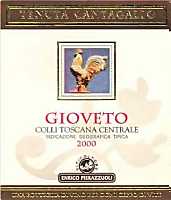
|
|
Gioveto 2000 |
|
| Tenuta Cantagallo (Italy) | |
| Grapes: Sangiovese (60%), Merlot (20%), Syrah (20%) | |
| Price: € 15,80 | Score: |
| The wine shows a deep ruby red color and nuances of garnet red, little transparency. The nose denotes intense, clean, pleasing, refined and elegant aromas that start with hints of black cherry jam and dried plum followed by aromas of blueberry jam, black currant, dried violet, licorice, tobacco, toasted wood, vanilla and hints of menthol, black pepper and clover. In the mouth has good correspondence to the nose, a slightly tannic attack and pleasing roundness, well balanced by alcohol, full body, intense flavors, good tannins, agreeable. The finish is persistent with good flavors of black cherry, plum and black currant. A well made wine. Gioveto ages for 10 months in barrique and for 10 months in bottle. | |
| Food Match: Game, Braised and stewed meat, Hard cheese | |
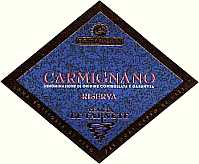
|
|
Carmignano Riserva 2000 |
|
| Tenuta Le Farnete (Italy) | |
| Grapes: Sangiovese (80%), Cabernet Sauvignon (20%) | |
| Price: € 19,80 | Score: |
| This wine shows an intense ruby red color and nuances of ruby red, little transparency. The nose reveals good personality with intense, clean, pleasing and refined aromas which start with hints of plum, black cherry and blackberry followed by aromas of bell pepper, violet, licorice, tobacco, vanilla and hints of menthol. In the mouth has good correspondence to the nose, a slightly tannic attack and however balanced, full body, intense flavors, good tannins. The finish is persistent with flavors of black cherry and plum. This wine ages for 24 months in barrique and for 12 months in bottle. | |
| Food Match: Game, Braised and stewed meat, Roasted meat, Hard cheese | |
|
||||||||
|
DiWineTaste Polls
|
| |||||||
Privacy Policy | |||||||


| Copyright © 2002-2024 Antonello Biancalana, DiWineTaste - All rights reserved |
| All rights reserved under international copyright conventions. No part of this publication and of this WEB site may be
reproduced or utilized in any form or by any means, electronic or mechanical, without permission in writing from DiWineTaste. |